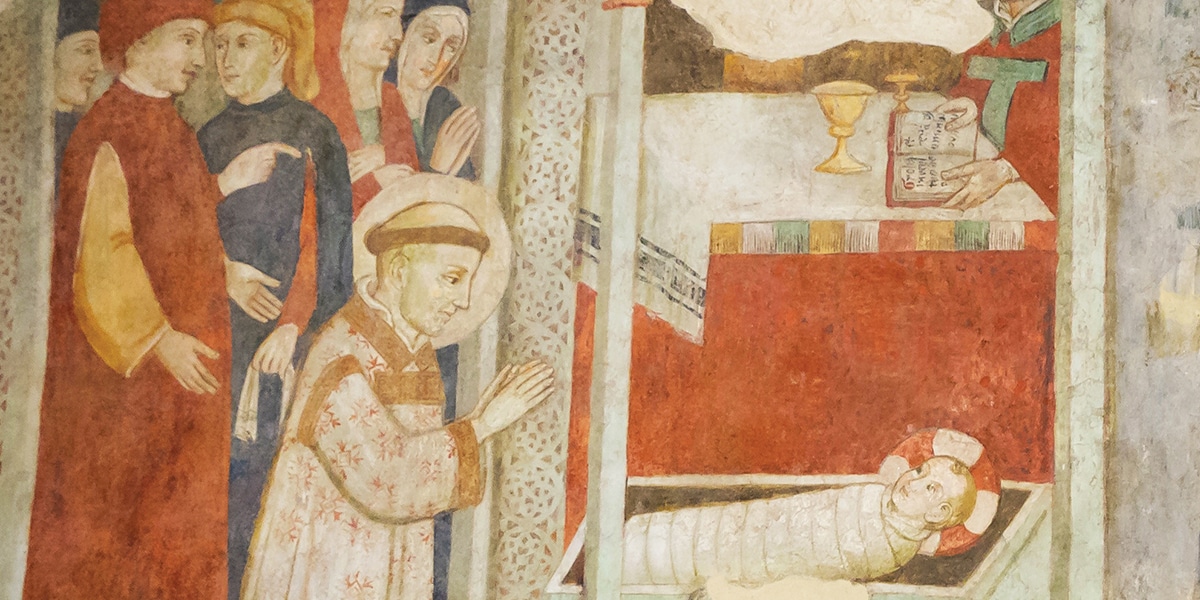While the tradition of a live Nativity scene dates back to 1223, St. Francis’ approach to the incarnation and the birth of Jesus remains revolutionary and spiritually transformative for today.
Years ago, I had a beagle named Gracie, a sweet but neurotic dog who created havoc when left alone for long periods of time. Her anxiety became a problem for me when neighbors complained about her barking. So I called upon my dog-loving friends who enjoyed an occasional “dog-fix” as dog sitters. I was deeply grateful when one of them was available to hang out with a cute beagle whom they affectionately dubbed “the love sponge.” It was a win-win situation.
One faithful dog sitter was a young graduate student who would come over when she could, do a little homework, pay a lot of attention to Gracie, and apparently listen to Christmas music regardless of the month or season of the year. I discovered her musical preferences one night in July when I returned home and discovered the cassette of Bing Crosby’s Merry Christmas album in the stereo.
At the time, I thought it was quaint that this young woman loved Christmas so much. But lately, I recognize the tender wisdom this young student harbored in her heart to offer companionship to a fearful dog who needed presence, to provide peace of mind to a professor who needed help keeping peace with her neighbors who complained about barking dogs, and to surround herself with music that offered the comfort and solace of the Incarnation.
This memory came to me when I was preparing a lecture on the role of laity in the Franciscan tradition. As part of the lecture, I thought I would tell the story of Greccio—but with a new twist.
The Forgotten Laity
Having studied and prayed at the fresco in the cave chapel at Greccio, I knew that I wanted to zero in on that group of laypeople standing behind Francis, adoring the Christ Child. I anchored my thoughts on the goal of putting a spotlight on that mostly anonymous group of laity led by John and Alticama Velita, the local nobleman and his wife who were prominent and close enough to Francis to be mentioned by name in the sources.
I jotted down all the pages in the Early Documents of Francis of Assisi on which the word Greccio appeared. I wanted to read different accounts of the story, but I also wanted to understand how Francis came to know and love the place and its inhabitants.
I learned that Francis often passed through the Rieti Valley with its many hamlets and villages and found a special connection with the people of Greccio because of their faith. With this little glimpse into the fervent faith of the laity of the time, we can appreciate how much ordinary men and women—much like you and me—cared for their faith. They attended church services as a community, but the people of Greccio are known to have further nurtured their devotions in their homes.
Through their shared devotional practices and liturgies, they also created a community knitted together through faith, perseverance, and presence. Francis perceived this special quality of faith and devotion when he first visited, perhaps as early as 1209 on his travels to and from Rome for the first time.
Fleshing out my reading from the early sources, I came to appreciate that Francis’ attraction to the place and his sense of comfort in Greccio came from its remote and wild location. Francis was willing to accept a place for a simple hermitage from his wealthy friend John only because of the latter’s own deep faith. Far from boasting of his elite titles and expansive landholdings, John viewed his social standing without much attachment and offered Francis a place on which a humble hermitage could be built. As the story goes, the exact location was selected by a youth who flung a torch across a ravine; it settled on the hillside where the present hermitage is located. This became a place where Francis gravitated to be in solitude and prayer.
The Need for Solitude
Francis’ love of solitude came up over and over in the sources I read of his visits to Greccio. So often, we can think of Francis as that joy-filled, youthful troubadour, but even more often, Francis persistently and actively sought to be alone. Solitude is where Francis cultivated his relationship with Christ.
By 1223, when the more famous story of Francis at Greccio took place, Francis was experiencing the weight of disappointment and frustration over the developing institutionalization of the brotherhood. Added to his emotional suffering was the significant physical pain caused by his chronic eye condition, known today as trachoma. Having treated his body with a fair amount of disdain in the name of penance, he arrived in Greccio physically weak and likely emotionally drained. He was making his way back to Assisi from a trip to Rome, where the Rule of 1223 was approved. His aspiration of a simple path to follow Jesus had become cluttered and complex within the order. He likely felt alone and isolated in this aspiration.
Isolation is, of course, different from solitude. While Francis had often sought solitude to be with Christ and to nurture his faith, this sense of isolation was potentially soul-crushing.
Is it any wonder, then, that in December 1223, as the late-autumn winds were growing cold, Francis arrived at his beloved Greccio, a place and a community that brought him hope by surrounding him in the love of faith?
Thomas of Celano’s account of the famous story at Greccio describes Francis’ inner state: “[Francis’] highest aim, foremost desire, and greatest intention was to pay heed to the holy Gospel in all things and through all things. . . . So thoroughly did the humility of the Incarnation and the charity of the Passion occupy his memory that he scarcely wanted to think of anything else.”
A Living Nativity
Dedicated to retracing Christ’s footsteps, Francis considered creating a living Nativity to celebrate Jesus’ birthday. Without his good friend John—a man who knew how to get things done in the real world—Francis’ hope and aspiration to experience consolation in a faithful re-creation of the Incarnation likely would have remained a silent thought in the solitude of his cell. As a colleague of mine often remarks, “Francis couldn’t organize lint in his pocket.” Organizing a living Nativity was beyond Francis’ capability, but it was not beyond John’s.
Fifteen days before Christmas, Francis summoned John and told him he wanted to have a living Nativity scene, complete with animals, hay, a manger, and a baby. He wanted to see, touch, and smell all there was to sense in the baby’s own awkward place, lying in an animal’s food trough. Just as Francis himself was experiencing discomfort and anguish—both physical and emotional—he wanted to share in the experience of the baby Jesus. He knew that it would be through visceral engagement, using all his senses, that he would find solace, hope, and compassion. Although he usually sought solitude, he asked to experience this in community, and he asked his friend John to make it happen.
Celano offers little detail about the work John brought to this task. Celano tells us that when “the day of joy” had arrived, Francis found all things had been prepared: “The manger is prepared, the hay is carried in, and the ox and the ass are led to the spot. . . . Out of Greccio is made a new Bethlehem.”
Getting the Job Done
If any of you have ever helped organize a Christmas pageant, you know that things don’t just get done by themselves. Many hands and minds go into such an event. Preparing a place, locating the hay, making a manger, finding the suitable animals with manageable demeanors, and convincing parents to allow their baby to be exposed to such a vulnerable (albeit auspicious) role on an early winter’s night all took managerial skills and the collaboration of many people.
Francis may have had the idea, but he needed the oversight of someone with significant skills in coordinating the efforts of many people and animals. Francis needed John. And John needed the collaboration of many other people—all of whom are anonymous in the historical record—but whose support, interest, and physical assistance contributed to making the living Nativity happen.
As people gathered with their candles and torches, lighting up the night and taking the chill off the winter’s cold, there emerged among those present at the living Nativity a deeper awareness of connection and interdependence. Along with the recognizable sounds of the snorts and munching of the animals, the familiar smells of candle wax mixed with animal dung, there grew a shared anticipation.
In one of the most poignant passages in Christian literature, Celano writes: “The night is lit up like day, delighting both man and beast. The people arrive, ecstatic at this new mystery of new joy. The forest amplifies the cries, and the boulders echo back the joyful crowd. The brothers sing, giving God due praise, and the whole night abounds with jubilation.” Within this energized setting in which people, animals, forests, and boulders are all active participants, Francis, the poor man from Assisi who so frequently sought solitude, stood before the manger and uttered “heartfelt sighs.” Mass was celebrated, and a spirit of joy replaced Francis’ habitual “contrite piety.”
Inspired by a Baby
Forsaking his habit of solitude, in his pain and suffering, Francis began to preach to all who had gathered. Taking up that common trait many of us have when in the presence of a baby, Francis used words and mannerisms that surely made people smile and laugh. Standing by a sheep, he blurted out “bebebeBabe of bebebebeBethlehem.” His bleating was met with the bleating of the nearby sheep. The donkey brayed in the familiar “hee-haw” sound.
And the babe? The baby at the center of all this woke up. I like to think the baby cried a little and then gurgled as babies do. The crowd that had been so hushed swooned over the baby as the donkey and the sheep looked over to see what little being was making this new noise.
This may sound a little chaotic to us, but for the people of Greccio, this scene would have offered a sense of fresh familiarity: their daily, mundane realities were made sacred through the Incarnation. After all, the people would have been used to living in close proximity to one another and with their animals, which were brought into their living quarters on frigid nights for shared warmth and well-being.
Solitude was an experience most people did not experience in the Middle Ages. While vowed religious, such as Francis, could experience the novelty of seclusion, in which they prayed, reflected, and generally turned inward to experience God, most laity prayed in community, reflected in community, and practiced faith in community through acts of charity.
We can see at Greccio that, two years before he began composing the “Canticle of the Creatures,” Francis was already moving more deeply into a spirituality of interdependence that allowed him to experience his discomforts and distress, pain and frustrations, just as the Christ Child did: in raw vulnerability and in simple honesty of the realities of lived experience.
Rather than withdrawing into solitude, Francis chose this moment to embrace what it means to be human: to depend on others and to be surrounded by all of creation. Right there, all of nature showed up to be authentically present without artifice or pretense—braying, bleating, singing, gurgling, smiling, giggling, crying, echoing these sounds—in short, celebrating the divine made incarnate.
We Are All Connected
There is a level of interconnectedness and interdependence that this story reveals when we flesh out some of the instinctive realities that Celano pushed into the background. This was not an elegant pageant to be watched. No, this was an experience of life, centered on and radiating out from the baby representing Christ—an experience of worshipping together in an interconnected way.
As I was retelling the Christmas story of Greccio in this way as part of my lecture, I realized that the audience had fallen into a hushed silence as they came to experience our own interconnectedness, our own interdependence in our shared faith. After the lecture ended, I watched as people left the auditorium. They seemed to me a little more tender with one another, more present with one another. Their mood and tenderness touched me.
As I walked to my car, I stopped and stood there alone in the parking lot for a few moments. Within moments, I heard the low, soft sound of an owl hoot as a gentle wind blew through the pine trees, making that particular sound reminiscent of an ocean wave. There I realized I wasn’t alone after all.
Now I understand why my young friend listens to Christmas music all year round. The miracle of the Incarnation soothes our nerves and softens our sense of independence in ways that open us up to the beauty of relationship and interdependence. This way of being—this experience of faith—is something to practice in every season.









3 thoughts on “Greccio and the First Live Nativity: 800 Years of Tradition ”
Especially enjoyed reading this since I was blessed to be in Greccio just a few days ago. Excellent writing for such a special place.
Darleen has a lot to offer in understanding Franciscan insight and vision of our humble relationship to God. Highly recommend her lectures.
11/27/23
Brings back such lovely memories of the liturgy and visit to Greccio in October.
Thx Darleen.
Marianne